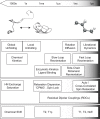Structural biology by NMR: structure, dynamics, and interactions
- PMID: 18818721
- PMCID: PMC2518859
- DOI: 10.1371/journal.pcbi.1000168
Structural biology by NMR: structure, dynamics, and interactions
Abstract
The function of bio-macromolecules is determined by both their 3D structure and conformational dynamics. These molecules are inherently flexible systems displaying a broad range of dynamics on time-scales from picoseconds to seconds. Nuclear Magnetic Resonance (NMR) spectroscopy has emerged as the method of choice for studying both protein structure and dynamics in solution. Typically, NMR experiments are sensitive both to structural features and to dynamics, and hence the measured data contain information on both. Despite major progress in both experimental approaches and computational methods, obtaining a consistent view of structure and dynamics from experimental NMR data remains a challenge. Molecular dynamics simulations have emerged as an indispensable tool in the analysis of NMR data.
Conflict of interest statement
The authors have declared that no competing interests exist.
Figures


References
-
- Wishart DS. NMR spectroscopy and protein structure determination: Applications to drug discovery and development. Curr Pharm Biotechnol. 2005;6:105–120. - PubMed
-
- Liu HL, Hsu JP. Recent developments in structural proteomics for protein structure determination. Proteomics. 2005;5:2056–2068. - PubMed
-
- Altieri AS, Byrd RA. Automation of NMR structure determination of proteins. Curr Opin Struct Biol. 2004;14:547–553. - PubMed
-
- Tugarinov V, Hwang PM, Kay LE. Nuclear magnetic resonance spectroscopy of highmolecular-weight proteins. Annu Rev Biochem. 2004;73:107–146. - PubMed
-
- Bouvignies G, Markwick PRL, Blackledge MJ. Simultaneous definition of high resolution protein structure and backbone conformational dynamics using NMR residual dipolar couplings. Chemphyschem. 2007;8:1901–1909. - PubMed
Publication types
MeSH terms
Substances
LinkOut - more resources
Full Text Sources
Other Literature Sources

